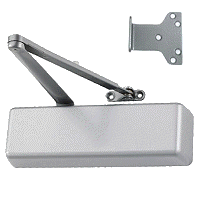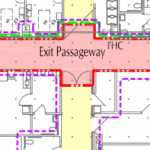This post was published in Doors & Hardware
 Two very common accessibility issues for door openings can usually be addressed by making simple adjustments. The accessibility standards require accessible doors to be opened with a limited amount of opening force, and to close slowly. Often these requirements can be met by properly adjusting the spring power and the valves of the door closer.
Two very common accessibility issues for door openings can usually be addressed by making simple adjustments. The accessibility standards require accessible doors to be opened with a limited amount of opening force, and to close slowly. Often these requirements can be met by properly adjusting the spring power and the valves of the door closer.
Opening Force
The opening force requirements are the same for both the 2009 and 2017 editions of ICC A117.1 – Accessible and Usable Buildings and Facilities (Section 404.2.8), and the 2010 Americans With Disabilities Act Standards (Section 404.2.9). The maximum opening force for interior hinged doors is 5 pounds. The maximum opening force for sliding and folding doors is also 5 pounds. Both standards note that the 5-pound force limitation does not apply to the force required to retract latch bolts or disengage other devices that hold the door in a closed position (refer to this Decoded article for more information on the forces for operable hardware as well as the 2021 IBC requirements for opening force).
In earlier editions of the standards, the opening force for exterior doors was addressed, but the current ICC A117.1 and ADA standards do not include an opening force requirement for exterior doors. The opening force limitation may be addressed in local codes, with some local requirements ranging from 15 pounds to 5 pounds for exterior doors. When local codes do not address opening force, the limits stated in the adopted building code typically apply. The difficulty with exterior doors is that adjusting the door to a low opening force and consequently a low closing force will sometimes result in an exterior door that is unable to close properly. Wind, air pressure, weatherstrip, latchbolts, and other conditions contribute to the problem. Check your adopted codes to determine opening force requirements for these doors.
Fire doors are exempt from the 5-pound force limitation in the accessibility standards, and are subject to the minimum opening force allowable by the appropriate administrative authority. Although NFPA 80 – Standard for Fire Doors and Other Opening Protectives, does not include a requirement for the amount of force used to open or close a fire door, Annex A of NFPA 80 does address the need for adequate spring power to ensure that the door is closed and latched, while taking into consideration the potential difficulty of opening a fire door. Annex A recommends a size-3 closer for interior 3-foot-wide fire doors, and a size-4 closer for exterior fire doors. Wider doors or doors with abnormal air pressures or other circumstances may require an increase to the next spring size. The closer “size” refers to the spring power, which correlates to the opening and closing force.
While fire doors are not required to open with 5 pounds of force, the maximum opening force for all egress doors, including fire doors and exterior doors, is addressed in the International Building Code (IBC). The IBC’s maximum allowable opening force for exterior doors and fire doors is a force of 30 pounds to set the door in motion, and 15 pounds to open the door to the fully-open position. Power-operated doors are subject to the same requirements except that the maximum force to set the door in motion is 50 pounds, however, the BHMA standards for automatic doors impose a more restrictive limit – 30 pounds to set the door in motion.
Closing Speed
The closing speed of an accessible door is addressed in Section 404.2.7 of the 2009 and 2017 editions of ICC A117.1 and Section 404.2.8 of the 2010 ADA Standards: “Door closers and gate closers shall be adjusted so that from an open position of 90 degrees, the time required to move the door to a position of 12 degrees from the latch is 5 seconds minimum.”
Again, this requirement can easily be met by adjusting the closer – this time by limiting the flow of fluid via the adjustment valves, and slowing the closing speed. At one time, a common practice was to equip accessible doors with delayed action closers, which delay the closing cycle for 1-2 minutes when opened to the fully-open position. While there may be some doors for which delayed action closers would be a good application, they are not required by the accessibility standards, and can even hinder the operation of some doors.
The closing speed for spring hinges is also addressed in the accessibility standards: “Door and gate spring hinges shall be adjusted so that from the open position of 70 degrees, the door or gate shall move to the closed position in 1.5 seconds minimum.” Although spring hinges are not prohibited by the accessibility standards, their use on accessible doors should be carefully considered, as they do not truly control the door. If spring hinges are used on fire doors, Annex A of NFPA 80 recommends that spring hinges should be adjusted to achieve positive latching when allowed to close freely from an open position of 30 degrees.
When a door closer can not be adjusted to meet the accessibility requirements for opening force and closing speed, a good option is to install an automatic operator. The 2009 edition of ICC A117.1 and the 2010 ADA Standards do not require the installation of automatic operators on accessible doors per se, although there are some state codes that do require them in certain circumstances. (Note: The 2017 edition of ICC A117.1 and the 2021 edition of the IBC require automatic operators for public entrances, and there is more information here.) Most door closers sold today are capable of being adjusted for use on an accessible door or on a fire door, but in situations where a door closer will not properly control the door within the limitations of the accessibility standards, an automatic operator should be considered.
Recommended Methods for Measurement
The accessibility standards do not go into detail about how to measure the opening force and closing speed, but there are recommended methods included in ANSI-BHMA A156.4-2019 – ANSI Standard for Door Controls-Closers.
A14 Recommended Method for Measuring Force Compliance to ADA
1. On the push side of the door, locate a point on the horizontal center line of the push plate or lock trim, at 1 inch from the latch edge of the door.
2. Mark the floor at a point where the push side of the door’s latch stile is at 70 degrees. Mark a second point where the push side is 3 inches from the latch.
3. Open the door so the latch is clear of the strike and the door is slightly off the stop.
4. Using a force gage on the mark determined in Step 1, gradually push the door open to the 70-degree mark established in Step 2. Observe the maximum force reading.
A15 Recommended Method for Measuring Closing Time Compliance to ADA
1. On the push side of the door, locate a point on the center line of the push plate or lock trim, or at 30 inches (762 mm) from the hinge edge of the door, whichever is greater. Mark the floor at a point 30 inches from the hinge pivot when the door is open to the 12-degree position and another on the same side of the door when door is at the 90-degree position.
2. Hold the door at the 90-degree mark. Release the door and time the closing sweep between the two marks.
You need to login or register to bookmark/favorite this content.







What is the current maximum effort required to operate a Sliding Glass Door (Patio door)? If the patio door is located on a balcony and is treated as a secondary door, will that then make the ADA guidelines less enforceable?
Hi Florence –
The ADA and A117.1 require sliding doors to operate with 5 pounds of force, if the door in question is required to meet the accessibility requirements.
– Lori
What is the national standard for closing speed for a exterior door?
Interior doors are 4 pounds and I thought 7pounds is acceptable for exterior.
Hi Kenny –
I think you may be asking about opening force for an exterior door, rather than closing speed. The closing-speed limit is stated in the article, “Door closers and gate closers shall be adjusted so that from an open position of 90 degrees, the time required to move the door to a position of 12 degrees from the latch is 5 seconds minimum.”
The opening force for interior, non-fire-rated doors on an accessible route is 5 pounds. For exterior doors, the limit is as required by local codes and standards. If a local limit has not been set, the IBC limits the opening force to 15 pounds to release the latch, 30 pounds to set the door in motion, and 15 pounds to swing the door to the full-open position. Power-operated doors are subject to the same requirements except that the maximum force to set the door in motion is 50 pounds.
– Lori
I’m wandering if anybody can hElphinstone.
I am looking for somewhere in can buy an LCN 4820 door closer from.
Thanks in advance.
Hi Stephen –
Tell me where you’re located and I’ll try to help.
– Lori
I see that there is a minimum close time of 5 seconds on a handicap door closer.
Is there a minimum time that the door needs to hold open before it begins to close?
Hi Jerry –
For a manual door, there is no minimum hold-open time. Standard closers (without the delayed action feature) start to close as soon as the person lets go of the door. There is a minimum hold-open time for automatic doors.
– Lori
I work at a CVSP (prison). I’m trying to find out how much force (lbs) it takes to open the security doors for offices, locked buildings, locked restrooms, etc. for the ‘free-staff’. I just had surgery and not suppose to lift more than a gal of milk. Please help
Hi Kelly –
There are tools that can be used to measure the opening force, but a fish scale might be your best bet if you don’t need a very precise measurement.
– Lori
.Hi Lori
I.am investigating an accident where an elderly female was hit by an outward opening door in a corridor.She was thrown to the floor resulting in a broken hip joint and broken wrist. The person who opened the door did not know she was the otherside of the door when he opened it.
Do you know of anything that could improve this situation from reoccurring.
Best regards Mike.
Hi Mike –
A vision panel in the door could help (depending on the room that door is serving), and I would make sure that the closer has backcheck to limit the opening cycle once the door gets to around 70 degrees.
– Lori
Hi Lori,
I’m trying to assist a client here in California and have a question on the Door Opening force CBC 1010.1.3-
These forces do not apply to the force required to retract latch bolts or disengage other devices that hold the door in a closed position.
This must include closers “devices that hold the door in a closed position”. We know NFPA101 specifically states “without a closer”. Based on this, I should be able to remove the surface mounted closer and check the opening force, since the requirement does not include the force necessary to disengage other devices that hold the door in a closed position. I can meet the 5lb requirement and reinstall the closer. The door meets the requirements stated in CBC 1010.1.3 Door Opening Force. Can it be that easy or am i missing something?
Hi Robby –
I don’t think it can be that easy. 😉
And I know 101 references doors without a closer, but that’s on my wish list to address in the next code development cycle because it doesn’t make sense from an accessibility standpoint. In all interpretations that I’ve seen, you would measure the opening force with the closer attached, unless the closer is being removed permanently.
– Lori
it’s not logical, it’s a code! The closer is going to be something everyone will have to contend with, but as it’s written, it’s telling me that “These forces”, i.e., the 5lb opening force requirement, do not apply to the force required to disengage devices (closer) that hold the door in a closed position. This takes me back to the days of police academy almost 30 years ago, and all the instruction on reading and understanding laws. We threw out all of our ideas of what the law meant, and our instructors would remind us to not read into it-the law means what it says and it says what it means. The interpretation will be done in court-or in this case, most likely by the AHJ-but it should be done in court.
All of which brings me to my last question, what would be the steps to be heard in an attempt to get the code changed, so we’re not tasked with the impossible? My concern is that by not being 100% compliant with the code, as contractors, we’re leaving ourselves out there. In California the 5lb requirement applies to exterior doors as well, but we have wind and weather like many other places, and meeting that 5lb requirement is in most situations, impossible. We can’t change the weather, but is there anything we can do about the code?
Thank you so much for everything you do, you’ve saved me so many times, and always at a minimum make my life easier. If you’re ever up in the SF Bay Area, please reach out, we’d love to buy you lunch. Thanks again.
Thanks Robby –
I spoke with my counterparts in California and they confirmed that the opening force limit comes from the accessibility requirements under CBC 11B-404.2.9 and that the testing is done with the closer attached and functioning. I know NFPA 101 makes reference to doors without closers, but a) 101 is the only model code/standard that says this, and b) the CBC is based on the IBC, not on NFPA 101.
– Lori